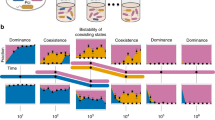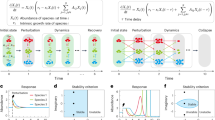Abstract
Tipping points, at which complex systems can shift abruptly from one state to another, are notoriously difficult to predict1. Theory proposes that early warning signals may be based on the phenomenon that recovery rates from small perturbations should tend to zero when approaching a tipping point2,3; however, evidence that this happens in living systems is lacking. Here we test such ‘critical slowing down’ using a microcosm in which photo-inhibition drives a cyanobacterial population to a classical tipping point when a critical light level is exceeded. We show that over a large range of conditions, recovery from small perturbations becomes slower as the system comes closer to the critical point. In addition, autocorrelation in the subtle fluctuations of the system’s state rose towards the tipping point, supporting the idea that this metric can be used as an indirect indicator of slowing down4,5. Although stochasticity prohibits prediction of the timing of critical transitions, our results suggest that indicators of slowing down may be used to rank complex systems on a broad scale from resilient to fragile.


Similar content being viewed by others
References
Scheffer, M. et al. Early-warning signals for critical transitions. Nature 461, 53–59 (2009)
Wissel, C. A universal law of the characteristic return time near thresholds. Oecologia 65, 101–107 (1984)
van Nes, E. H. & Scheffer, M. Slow recovery from perturbations as a generic indicator of a nearby catastrophic shift. Am. Nat. 169, 738–747 (2007)
Ives, A. R. Measuring resilience in stochastic systems. Ecol. Monogr. 65, 217–233 (1995)
Dakos, V. et al. Slowing down as an early warning signal for abrupt climate change. Proc. Natl Acad. Sci. USA 105, 14308–14312 (2008)
Scheffer, M. Critical Transitions in Nature and Society (eds Levin, S.A. & Strogatz, S.H.) (Princeton Univ. Press, 2009)
Kleinen, T., Held, H. & Petschel-Held, G. The potential role of spectral properties in detecting thresholds in the Earth system: application to the thermohaline circulation. Ocean Dyn. 53, 53–63 (2003)
Held, H. & Kleinen, T. Detection of climate system bifurcations by degenerate fingerprinting. Geophys. Res. Lett. 31, L23207 (2004)
Carpenter, S. R. & Brock, W. A. Rising variance: a leading indicator of ecological transition. Ecol. Lett. 9, 311–318 (2006)
Strogatz, S. H. Nonlinear Dynamics and Chaos: With Applications to Physics, Biology, Chemistry and Engineering 1st edn (Addison-Wesley, 1994)
Dakos, V., van Nes, E. H., D’ Odorico, P. & Scheffer, M. How robust are variance and autocorrelation as early-warning signals for critical transitions? Ecology (submitted); preprint at http://dx.doi.org/10.1890/11-0889.1
Carpenter, S. R. et al. Early warnings of regime shifts: A whole-ecosystem experiment. Science 332, 1079–1082 (2011)
Drake, J. M. & Griffen, B. D. Early warning signals of extinction in deteriorating environments. Nature (2010)
Huisman, J. The Struggle for Light. PhD thesis, Univ. Groningen. (1997)
Gerla, D. J., Mooij, W. M. & Huisman, J. Photoinhibition and the assembly of light-limited phytoplankton communities. Oikos 120, 359–368 (2011)
Holmgren, M., Scheffer, M. & Huston, M. A. The interplay of facilitation and competition in plant communities. Ecology 78, 1966–1975 (1997)
Scheffer, M., Carpenter, S. R., Foley, J. A., Folke, C. & Walker, B. Catastrophic shifts in ecosystems. Nature 413, 591–596 (2001)
Dakos, V., Kéfi, S., Rietkerk, M., van Nes, E. H. & Scheffer, M. Slowing down in spatially patterned ecosystems at the brink of collapse. Am. Nat. 177, E153–E166 (2011)
Huisman, J. et al. Principles of the light-limited chemostat: theory and ecological applications. Antonie Leeuwenhoek. 81, 117–133 (2002)
Andersen, R. A. Berges, J.A., Harrison, P.J. & Watanabe, M.M. in Algal culturing techniques 1st edn 435–436 (Elsevier, 2005)
Huisman, J. & Weissing, F. J. Light-limited growth and competition for light in well-mixed aquatic environments: an elementary model. Ecology 75, 507–520 (1994)
Acknowledgements
We thank M. B. Gonçalves Souza for discussions on the experimental set up. We thank D. Waasdorp and W. Beekman-Lukassen for assistance with the experiments and C. ter Braak for statistical advice. A.J.V., E.J.F., V.D., E.H.v.N. and M.S. are supported by a European Research Council Advanced grant and M.S. is the recipient of a Spinoza award.
Author information
Authors and Affiliations
Contributions
A.J.V., E.J.F. and M.L. performed the experiments. A.J.V., E.J.F, E.H.v.N. and V.D. analysed the data. M.S., A.J.V., E.H.v.N., E.J.F. and V.D. wrote the paper. All authors discussed the results and commented on the manuscript.
Corresponding author
Ethics declarations
Competing interests
The authors declare no competing financial interests.
Supplementary information
Supplementary Information
The file contains Supplementary Notes 1-4, Supplementary Figures 1.1, 2.1 and 4.1, Supplementary Table 4.1 and additional references. This file was replaced on 18 April 2012. (PDF 1497 kb)
PowerPoint slides
Rights and permissions
About this article
Cite this article
Veraart, A., Faassen, E., Dakos, V. et al. Recovery rates reflect distance to a tipping point in a living system. Nature 481, 357–359 (2012). https://doi.org/10.1038/nature10723
Received:
Accepted:
Published:
Issue Date:
DOI: https://doi.org/10.1038/nature10723
- Springer Nature Limited
This article is cited by
-
Spatiotemporal dynamics of traffic bottlenecks yields an early signal of heavy congestions
Nature Communications (2023)
-
Convergence Speed and Growth Patterns: A Dynamical Systems Approach
Computational Economics (2023)
-
Dynamical indicators in time series of healthcare expenditures predict mortality risk of older adults following spousal bereavement
BMC Geriatrics (2022)
-
Universal constraint on nonlinear population dynamics
Communications Physics (2022)
-
Empirical evidence for recent global shifts in vegetation resilience
Nature Climate Change (2022)





